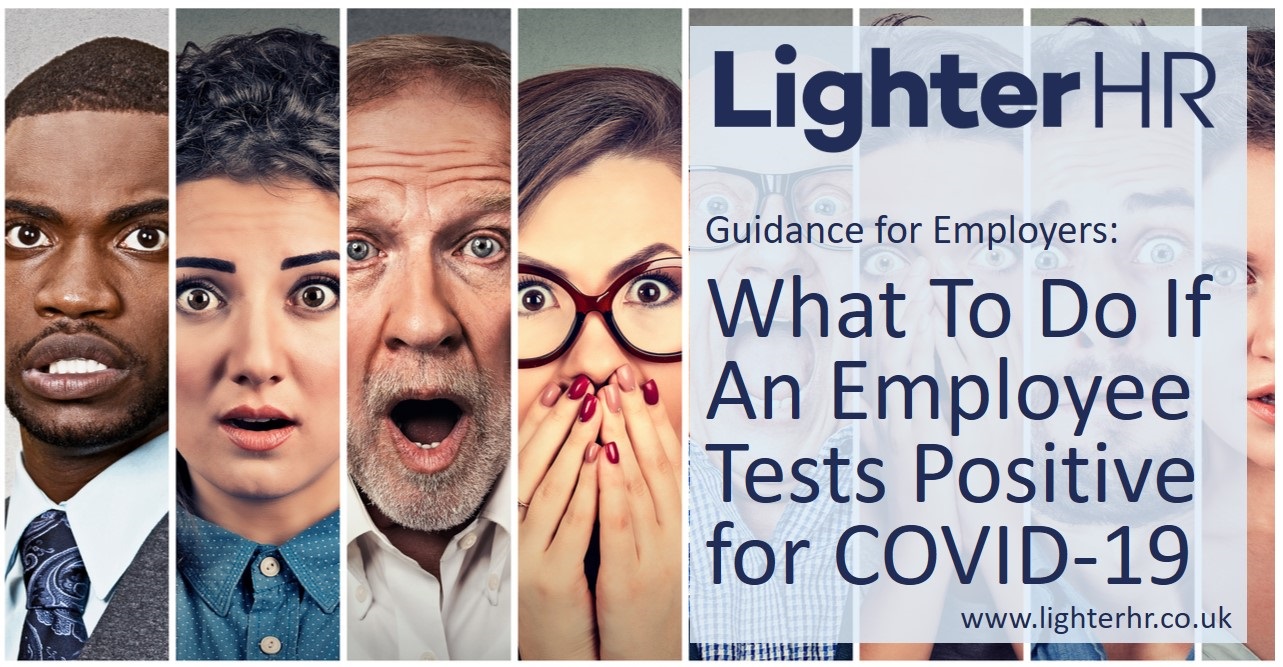Note: Information correct at time of publication.
As people start to return to offices, use public transport more and generally come out of lockdown, the chances of you finding yourself with an employee who tests positive for Covid-19 increase.
The purpose of this update is to help you be prepared if you face this situation.
The questions answered in this post are:
We strongly advise you to get in-touch with us on 0203 319 1649 to seek tailored guidance before you take any actions.
As with all of the guidance with coronavirus, we need to remind you that these are unprecedented times and it is unclear as to how employment law will be applied in these exceptional circumstances.
The information that follows has been compiled with input from government websites, Acas and HMRC (the only official resources that we’re happy to use as these are the institutions who will be responsible for enforcing the rules as we move forward), but the reality is no-one really knows for certain how actions that businesses need to take now will be interpreted later.
1. What should you do to manage a situation where an employee tests positive for Covid-19?
We’re hoping that you have not allowed employees to return to the office without having understood what you need to do in order to provide a Covid-secure workplace.
As a reminder, before employees returned to the office you needed to have:
- Conducted a risk assessment of the work environment, implemented remedial measures and then shared this information with all employees.
- Provided employees with detailed instructions of what actions they need to take in order to minimise the risk of spreading the virus (hand cleaning, social distancing, not sharing equipment, etc.)
- Displayed the document that is available from the government website that confirms what you’ve done.
If you are yet to complete all of the above, then now’s the time.
There is a great deal of very detailed and useful information on the government website that is tailored to different sectors. You can find it here: https://www.gov.uk/guidance/working-safely-during-coronavirus-covid-19/
2. What do I do if an employee calls in sick with Covid-19?
Don’t panic!
Remember, the steps that you have taken before people returned to work were designed to ensure that you were creating a Covid-secure work environment. This doesn’t mean that you created a workplace that is safe as long as no one catches Covid-19; it means that you’ve created a workplace that is safe even if someone does catch Covid-19. The steps that you have taken should have been sufficient to minimise the risk of the virus spreading between colleagues.
If you have provided a Covid-secure work environment, there should be no reason to send everyone home.
Here’s how we suggest you deal with the situation:
- Clearly, if the individual is at work when they discover they have tested positive for Covid-19, send them home immediately. You should remind all employees that, if they take a test they should not come to the office until such time as they have the test result.
- Work closely with the infected individual to understand who they believe they may have been in “close contact” with and whether the individual has been following the rules regarding handwashing etc. The most important thing here is that you create an environment in which the individual feels they can be honest with you without fear of reprimand if they haven’t followed the rules as you need to understand exactly what you’re dealing with.
- If the infected individual confirms that they have had “close contact” with someone, immediately send that person/those people home. Those individuals need to self-isolate for a period of 14 days. They may also want to get tested but, as a business, you need to remember that a negative test result does not negate the need to self-isolate or shorten the isolation period. You could receive a negative test result on Day 5 but have symptoms and test positive by Day 8. They must follow the self-isolation rules.
- As a reminder, “close contact” has a clear definition in relation to Covid-19 and is defined as:
- having face-to-face contact with someone (less than 1 metre away)
- spending more than 15 minutes within 2 metres of someone
- travelling in a car or other small vehicle with someone (even on a short journey) or close to them on a plane.
- You don’t need to inform your entire workforce that there has been a positive case of Covid-19 and, if you do decide to tell people, then you must protect the identity of the infected individual.
What we would encourage you to remember is, this is likely to happen repeatedly over the coming months so, the approach that you take when someone test positive needs to be proportionate and repeatable.
3. Do I need to tell any public body that I have a case of Covid-19 in the office?
In an office environment, where you have a single positive case, you have no reporting requirements. If you have multiple positive cases, then you need to contact your local health protection team.
If you operate in certain sectors, then even one case needs to be reported to the local health protection team. The need to report even a single case applies to employers operating:
- A health or care setting
- A prison or secure establishment
- A school for children with special needs.
4. What are the Covid-19 isolation rules?
They are quite complicated but here goes:
- If you receive a positive test result or have symptoms of Covid-19 then you need to self-isolate for at least 10 days. If you have symptoms, the 10 days starts from the day on which the symptoms started. If you do not have symptoms, the 10 days starts from the date on which you had the test.
- If you have a positive test result but did not have symptoms and then go on to develop symptoms, you need to re-start the 10-day isolation from the date on which your symptoms start.
- You can stop isolating after 10 days if you are feeling better and have no temperature. You may still have a cough or changes to your sense of smell or taste as these symptoms can continue for weeks after the virus has gone.
- If you live with (or are in a support bubble) with someone who has symptoms or who tests positive for Covid-19 then you need to self-isolate for 14 days from the date on which the person in your home or support bubble started symptoms or the day on which they were tested if they do not have symptoms. If the person tested positive and did not have symptoms but then goes on to develop symptoms, then the 14-day self-isolation period needs to be re-started from the date on which the symptoms develop.
- You can stop isolating after 14 days if you do not get symptoms. If you develop symptoms you should get a test and then follow the isolation rules associated with individuals who have the virus.
Employment Laws Still Apply
When making changes to working hours or other terms and conditions, assuming your employment contract does not already allow for that, normal employment law applies – refer to our post on employment law: Job Retention Scheme – Employment Laws Still Apply.
Also, the employer must be careful not to discriminate in deciding who to offer furlough too – refer to our post on furlough discrimination: Furlough Decisions – Beware of Unintended Discrimination.
Get In Touch

Speak with an HR Expert
Chat through your HR requirements with one of our expert consultants to understand the actions you can take and how we can help.


